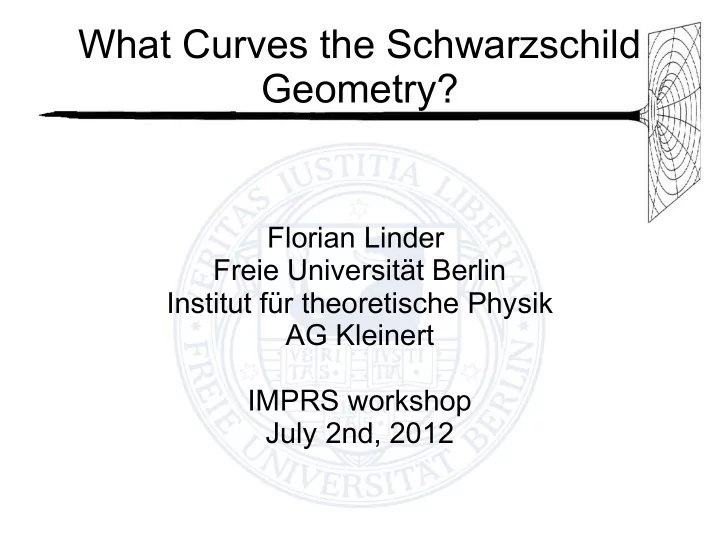

What Curves the Schwarzschild Geometry? Florian Linder Freie Universität Berlin Institut für theoretische Physik AG Kleinert IMPRS workshop July 2nd, 2012
Aim of my talk ● To present a different perspective on the Schwarzschild metric: The gravitational field of a point mass ● Problem of multiplication of distributions Gravity: nonlinear theory Distributions: linear functionals – 2 –
Literature I: Products of “Distributions” ● Schwarz (1951): theorem of the impossibility of the multiplication of distributions ● Colombeau (1984): Colombeau algebra embedding generalized functions via convolution with smooth “mollifiers” ● Kleinert (2000): Definition of special products of distributions by claiming general coordinate invariance of path integrals – 3 –
Literature II: “Distributions” in GR ● Geroch and Traschen (1987): defined a class of metrics which can be treated with distributional methods ● Regularization techniques (1990s) (e.g. Balasin and Nachbagauer (1993)) ● Heinzle and Steinbauer (2002) studied the Schwarzschild metric with Colombeau's theory of generalized functions → only possible in Eddington-Finkelstein coordinates – 4 –
Content ● Theory of Gravitation ● Schwarzschild Metric ● Analogy to Electrostatics: Schwarzschild metric → point mass ● Perturbative approach: Point mass → Schwarzschild metric ● Conclusion – 5 –
Theory of Gravitation ● General coordinate invariance: → Transformation of the metric: → Christoffel symbols, covariant derivative... – 6 –
Theory of Gravitation ● Idea: – Masses deform space-time – curvature causes forces ● Einstein equation: describes the deformation of space-time : Einstein tensor (nonlinear in the metric) : stress-energy-tensor (contains mass density) : gravitational constant – 7 –
Point Mass ● Stress-energy tensor of a point-mass at rest: ● Einstein Equation: – 8 –
Schwarzschild Metric ● Birkhoff's Theorem : The Schwarzschild metric is the only nontrivial solution of the vacuum Einstein Equation: of a spherically symmetric space-time. ● The line element is given by: – 9 – with:
Schwarzschild Metric ● Usual treatment: cut out the point r=0 of manifold ? → need not care about the divergency – 10 –
Electrostatics ● Field of a positive point charge: diverges at the origin ● Charge density: – via distributional interpretation – or by applying Gauss' theorem: – 11 –
Electrostatic → Gravitystatic ● Electric field becomes metric field ● Maxwell equation becomes Einstein equation – 12 –
What Curves the Schwarzschild Geometry? ● Corollary : A spherically symmetric static space-time which obeys is described by the following line element: Its Einstein tensor is given by: – 13 –
What Curves the Schwarzschild Geometry? ● See mass in with Gauss' theorem with: – 14 –
What Curves the Schwarzschild Geometry? ● Solution in spherical coordinates: – 15 –
What Curves the Schwarzschild Geometry? ● Change to Cartesian coordinates: This gives the expected stress-energy tensor of a point mass – 16 –
Perturbative Study of Point Mass ● Einstein equation for a point mass: ● Expand metric around the flat space-time: ● Inverse metric: ● Calculate Einstein tensor in order by order in – 17 –
Perturbative Study of Point Mass ● Solve differential equations: ● Obtain expansion of Schwarzschild metric in Schwarzschild coordinates order by order: ● But: convergence radius of geometric series is → no prediction for the origin – 18 –
Perturbative Study of Point Mass ● Einstein tensor to first order in : ● Gauge freedom of linear gravity: : arbitrary vector field → Gauge invariance broken in 2 nd order – 19 –
Perturbative Study of Point Mass ● Solve linear Einstein equation in (d >3) dimensions: – 20 –
Perturbative Study of Point Mass ● Find an appropriate gauge field: ● Derivative of : with: – 21 –
Perturbative Study of Point Mass ● Get the full Schwarzschild solution in Eddington-Finkelstein coordinates: – 22 –
Conclusion ● Problem solved with Colombeau algebra But only in Eddington-Finkelstein coordinates ● Regularization independent technique to see mass in Schwarzschild metric ● Perturbative approach: Gauge 1 st order solution → Schwarzschild metric in Eddington-Finkelstein coordinates ● Motovation for gauge via calculation in d>3 dimensions – 23 –
Conclusion ● Eddington-Finkelstein coordinates are the natural coordinates of a point mass – Results from the perturbative study of the Einstein equation – Only this choice of coordinates could be treated by Colombeau's theory of generalized functions ● Different coordinates of the Schwarzschild metric describe different space-times since coordinate transformations diverge at – 24 –
Literature L. Schwartz, Theorie des Distributions, Tomes I & II (Publications de l'Institut ● de Mathematiques de l'Universite de Strasbourg IX & X) . Hermann & Cie, Paris, 1st ed., 1951 J. F . Colombeau, New Generalized Functions and Multiplication of Distributions . ● Elsevier Science & T echnology, Maryland Heights, MO, 1984 H. Kleinert and A. Chervyakov, Reparametrization invariance of perturbatively dened ● path integrals. II. integrating products of distributions , Physics Letters B 477 (2000), no. 1-3 373-379 R. Geroch and J. Traschen, Strings and other distributional sources in general ● relativity , Physical Review D 36 (1987), no. 4 1017 H. Balasin and H. Nachbagauer, The energy-momentum tensor of a black hole, or what curves the Schwarzschild geometry? , Classical and Quantum Gravity 10 (1993), no. 11 22712278 J. M. Heinzle and R. Steinbauer, Remarks on the distributional Schwarzschild ● geometry, Journal of Mathematical Physics 43 (2002), no. 3 1493 – 25 –
Appendix Closing the manifold ● Origin of coordinates is cut out ● Coordinate invariance → Infinity of different possibilities ● But: Which differentiable structure? ● Choose the simplest/most physical one – 26 –
Appendix Eddington-Finkelstein coordinates ● Line element given by: ● Transformation from Schwarzschild to Eddington-Finkelstein coordinates: – 27 –
Appendix Eddington-Finkelstein coordinates Ingoing Outgoing Schwarzschild Eddington-Finkelstein Eddington-Finkelstein – 28 –
Appendix Kruskal coordinates – 29 –
Appendix Distributional calculation – 30 –
Recommend
More recommend